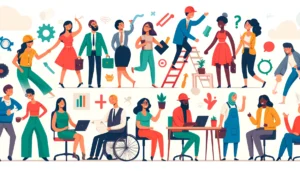An inclusive workplace needs to go beyond ramps and restrooms
- 4 Min Read
Exploring the broader scope of workplace inclusivity beyond physical infrastructure to include digital accessibility, policy reform, and cultural shifts.
- Author: HRD Connect
- Date published: Mar 25, 2024
- Categories

In our journey toward creating inclusive workplaces, it’s crucial to acknowledge that inclusivity extends far beyond the physical.
True accessibility encompasses digital platforms, comprehensive policy reform, and a cultural shift towards embracing diversity at every level. As we delve into these areas, we aim to equip HR professionals and leaders with the tools to foster a genuinely welcoming environment for all employees.
Digital Accessibility: The Unseen Frontier
The digital realm is an integral part of modern work, yet it’s often overlooked in discussions about workplace accessibility. Ensuring that all digital tools—from corporate websites to internal communication platforms—are fully accessible is not just about compliance; it’s about empowerment.
This means implementing design principles that accommodate everyone, including those with visual, auditory, and physical disabilities. Regular audits and updates of these digital assets are essential to maintain and enhance accessibility over time.
Policy Reform: Laying the Groundwork for Inclusion
Policies are the backbone of organizational culture, and reforming them to support inclusivity is a critical step. This involves not only providing flexible working conditions and access to necessary tools but also rethinking recruitment, retention, and promotion practices to eliminate barriers for people with disabilities.
Encouraging a dialogue around these policies can help ensure they are practical, respectful, and truly inclusive.
Cultural Shifts: Fostering an Environment of Acceptance and Support
Creating a culture that supports diversity and inclusion requires continuous effort and commitment. Training programs that focus on sensitization and empathy can help break down prejudices and foster a supportive atmosphere.
Encouraging open communication allows employees to feel comfortable discussing their needs, ensuring that inclusivity is not just a policy but a practice lived daily by everyone in the organization.
Implementing Change
The path to an inclusive workplace is an ongoing process that requires dedication and action. This calls for a proactive approach from HR professionals and leaders to assess current inclusivity measures, identify areas for improvement, and implement comprehensive strategies for change.
A commitment to regular review and adaptation of these strategies will ensure that inclusivity efforts are effective and enduring.
Roadmap for creating an inclusive workplace
- Conduct an Inclusivity Audit: Begin with a comprehensive audit of your current workplace practices, policies, and environment. Evaluate physical, digital, and cultural aspects to identify barriers that employees with disabilities might face. Use surveys and feedback from employees to inform your audit.
- Develop an Inclusive Vision and Policy: Based on the audit findings, develop a clear vision for what an inclusive workplace looks like for your organization. Update existing policies or create new ones that explicitly support inclusivity, such as accommodation policies, flexible work arrangements, and non-discrimination policies.
- Set Measurable Goals: Establish specific, measurable, achievable, relevant, and time-bound (SMART) goals for inclusivity initiatives. These goals could range from increasing the diversity of the workforce to improving digital accessibility within a set timeframe.
- Implement Training and Awareness Programs: Roll out comprehensive training programs focused on sensitization, disability etiquette, and inclusive communication. Ensure all employees, especially managers and team leaders, understand how to support their colleagues with disabilities.
- Improve Physical and Digital Accessibility: Based on the audit, make necessary adjustments to physical spaces and digital tools. This might include installing assistive technologies, redesigning websites for better accessibility, and ensuring that workspaces are physically accessible to everyone.
- Foster an Inclusive Culture: Encourage a workplace culture that celebrates diversity and inclusion. This can be achieved through regular inclusive events, recognition of diverse teams, and open forums for employees to share their experiences and suggestions.
- Monitor, Evaluate, and Adapt: Regularly monitor the effectiveness of inclusivity initiatives against the set goals. Collect feedback from employees to evaluate the impact of changes and adapt strategies as needed to ensure continuous improvement.
- Report and Celebrate Progress: Communicate the progress of inclusivity efforts to the entire organization. Celebrating successes not only reinforces the importance of inclusivity but also encourages ongoing commitment from all employees.








